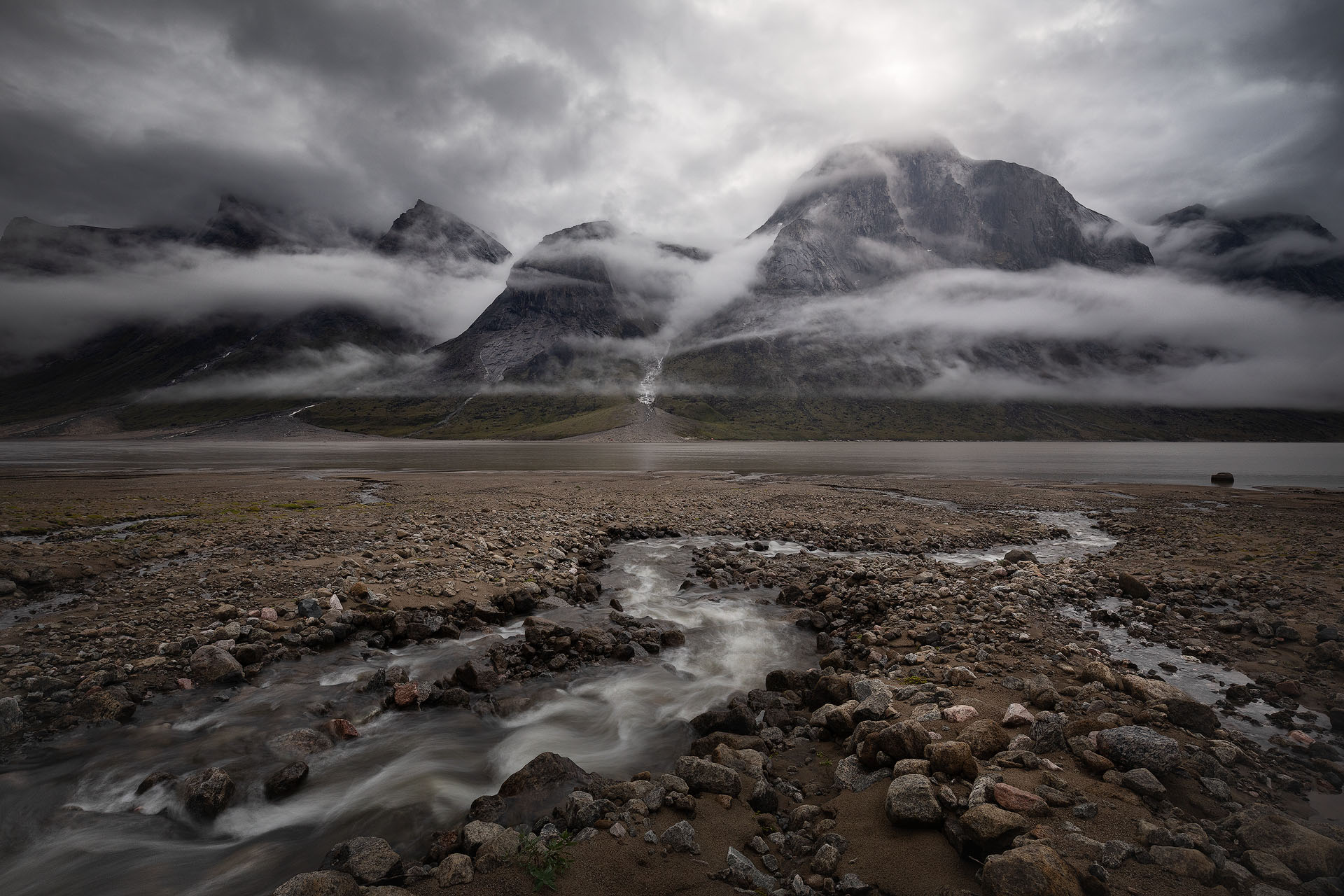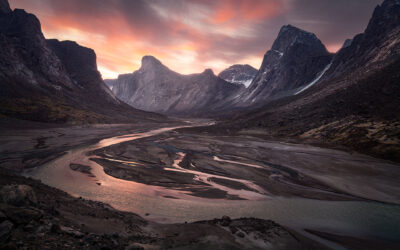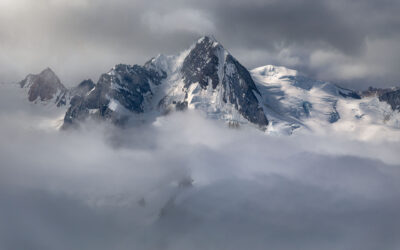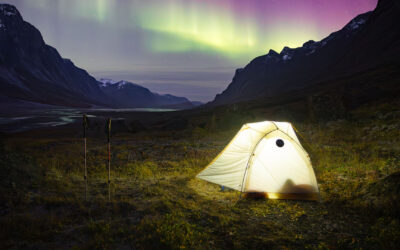When it comes to photographing far-off locations, I don’t think it’s uncommon for a photographer to have some special place in the back of their head that they’d like to visit but haven’t gotten there for one reason or another. Sometimes that spot may be a bit expensive, maybe it requires more time than a photographer can put aside, or sometimes it may take a skillset that a photographer hasn’t yet developed. I’ve experienced all of these reasons before, and even today there’s a number of places I’d love to visit but haven’t for one or more of these.
For a very long time, I had one specific park as number one on my list of places I wanted to visit, but hadn’t yet. Auyuittuq National Park on Baffin Island in Canada’s Nunavut Territory. While the park is mostly covered in ice, the Akshayuk Pass cuts through the Penny Icecap, flanked by some of the world’s most dramatic peaks. I’d dreamed of visiting this park for many years, and in 2023 I got my chance.
Visiting the park was supposed to be a dream come true – and in a lot of ways it was – but to be blunt, things did not go to plan. If you’d like to get a good view of how things went, have a peek the video below.
Now, compressing almost two weeks into a 30 minute video wasn’t really going to work, so the video really focuses on the bit of the trip that was to focused on photography. Some spoilers ahead, so if you plan on watching the video, now’s the time! The next sections will add a little behind the scenes to the video above. Read on if you want to get some more context on this monumentally frustrating trip.
So the weather really was that bad, and did create some pretty significant challenges. I know I made the right decision to leave when I did. However, there were a number of additional factors that contributed to the challenges, and many of which I couldn’t really get into in the video. Each of those challenges were learning experiences, and truthfully, I walked into a lot of those challenges because I was so adamant about completing the visit, and not giving up. I stayed focused on completing the trip until I had no choice but to turn around, and a lot of other things went wrong.
Problem #1 – Conditioning
I’ve always found that my creativity is pretty limited by energy. I’ve known for a long time that when I over-exert myself on a big hike, I tend to struggle when it comes time to be creative. If I’m completely exhausted, odds are I’m going to be less satisfied with the images I capture. For that reason, it’s incredibly helpful to moderate my energy use on these trips. Ensuring that I keep some gas in the tank helps to keep me creative when it matters.
As a general rule, I often work on improving my physical fitness for months leading up to larger hikes. This has been a great strategy to help me hike farther, or carry more weight before I start running out of that creative energy. Building up my fitness before a trip has been critical in the past, and it’s something I always aim to do.
Unfortunately for me this year, my training plan wasn’t going to cooperate. Shortly before leaving for this trip, my wife and I went on our honeymoon, meaning I couldn’t train in the way I usually would leading up to a trip. I was hopeful that I had done enough work earlier through spring to get me where I needed to be, but that just wasn’t going to cut it. To make matters worse, I got violently ill on our honeymoon, and only recovered shortly before leaving for Baffin Island.
I was hopeful that I had fully recovered and my fitness would carry me through, but that just wasn’t going to be enough. Much of my first day of hiking was a lot harder than it needed to be. The water was a lot higher than I expected it to be, and without having good familiarity with the terrain, I found myself walking on difficult ground to avoid the water. From boggy, to rocky, to quicksand, every step of day 1 was more work than it should have been. All of that meant that I was really tired when that first day ended. And it was the only full day of photography I got for the whole trip. Thankfully, the photography I did get went well, but as time went on, the exhaustion caught up to me.
I was so completely exhausted on night one that I was almost non-sensical. When I realized that the water levels were going to become dangerous, I knew I had to turn around – there was no way I had the energy to hike that far AND deal with sketchy river crossings. Some time later I would check my statistics on my smart watch and realize just how hard I’d worked on day one. I guess I burned nearly 6000 calories from that walk – more than double what I could have eaten. Obviously, that could not go on forever.
Problem #2 – The Weather
In the video I spend a lot of time talking about the weather, but there were a couple additional issues that came up as a result of it. One of the major issues was that this amount of rain can genuinely create additional risks, and even beyond river crossings. I got a good taste of these on my walk out on Day 2.
I was up early on Day 2 still with hopes that I’d be able to continue my hike. I had slept incredibly well – probably one of my deepest sleeps ever, and felt ready to roll right out the gate. After I pulled a satellite weather report, however, it was clear that I’d have to leave. Three days of non-stop rain was going to make those river crossings even worse, and with how my first crossing went, I knew that trying these on my own was a bad idea. I instead packed up my tent, and started my walk south, towards home.
According to the satellite weather report, the rain wasn’t supposed to start until around 3pm, but instead the rain started much earlier, with a full on rain storm by 9 am. It wasn’t long until my old and trusty rain jacket had fully wetted out, leaving me soaked. I tried to stay to the higher ground to avoid all the boggy areas, but this meant a whole lot more going up and down rocky hills, further exhausting me. While I woke up feeling strong and ready to go, it wasn’t long before my exhaustion really caught up to me again.
I found myself having to walk quite slowly, almost dragging myself along. I ended up taking a number of breaks, and in a few instances I debated just shutting down the hike and setting up the tent for the night to regain my energy. My body was in a lot of pain – my bag digging into my hips, my chest hurting from the exertion, and my fitness watch thinking I was doing the workout of a lifetime. Nevertheless, I decided to press on to the Ulu shelter. I knew I wouldn’t be able to dry anything in my tent, and after my jacket soaked through, I knew it was just a matter of time until I started getting really cold – unless I could get dry first. The shelter was certainly the better option.
The water had soaked me right to the bone by the time I arrived at Ulu shelter. I was shivering, not at all hungry, and my body had no interest in walking at all. As soon as I arrived, I emptied my bag inside the shelter, and dug out my sleeping pad, my pillow, and my -12 celsius sleeping bag. I was shaking from cold, and I knew that if I didn’t get warm soon, I could be in danger. The only way I was going to do that when all my clothes were soaked was going to be to strip down, dry off, and get into that sleeping bag. It was only maybe 3 in the afternoon, but I didn’t care – bed time had become an immediate necessity. I honestly don’t remember my head hitting the pillow because I was out like a light.
Later on in the early evening, I woke to what sounded like thunder, but with a much more consistent rumble. I jumped up out of my sleeping bag and looked out the shelter’s tiny window. It was a massive rock fall – a huge plume of dust was running down the mountain behind the shelter, and appeared to be coming right for me! I was scared stiff – I didn’t know what to do.
I distinctly remember thinking “If those rocks hit the shelter, I’ll be crushed! Do I leave the shelter and try to get farther away? I’m wearing nearly nothing and if the shelter is destroyed, hypothermia would get me anyway.”
I decided to just bide my time and see where the rocks went. Thankfully, the plume of rock seemed to drift off to the left before getting close to the shelter. I was safe, but again, I’d gained a serious reminder of how serious the weather could be up here. As it turns out, heavy rain in this park tends to increase the frequency of rock fall, and there had been a ton of rain.
Problem #3 – Communications and Cancellations
Exiting the park isn’t as simple as walking up to a parking lot, hopping into a car and heading away. No, the park is flanked by ocean on both sides, so you need a boat to come pick you up. Generally, you work with an outfitter to set a pick up time, and this works 99% of the time, but it really helps if the outfitter knows when to come get you, and my outfitter wasn’t expecting me for several more days. So in attempting to change the schedule, I tried to reach out to the outfitter using my GPS communicator, but we just couldn’t connect. I tried contacting the park, but again, I couldn’t get through. Not ideal – how was I going to get out of the park if I couldn’t reach anyone?
Several of the shelters in Auyuittuq National Park have two-way radios in them, including Ulu. When I got to Ulu on day 2, after hearing nothing on my GPS communicator, I tried using the 2-way radio. I knew I had some time before they stopped monitoring the radio for the day, and was hopeful I could get a message through, but unfortunately, my messages garnered no responses. I had no idea if no-one was on the other end, or if the radio wasn’t working, or if I just couldn’t hear their response. What I did know, however, was that the park released a weather report every morning, and if I couldn’t get to hear that weather report, then the radio must not be receiving properly. On the morning of Day 3, I tried to hear the report, and it was garbled. I was able to properly tune the radio so I could hear ok, but again, they couldn’t hear me. That radio was just not working, and not going to be an option.
I turned to my next resort – contacting someone at home using the GPS communicator. Thankfully I was able to get a hold of my good friend Dean, who called the park and coordinated my ride out. I didn’t know he’d figured it out though – I was ignorantly waiting at the shelter to hear more, until I got a delayed message from the outfitter noting that he’d be at the pick up in an hour. I was 5 kilometres from the pickup, and all of my stuff had exploded out into the shelter, so an hour was going to be a bit of a reach. Never the less, I haphazardly jammed all my stuff into my bag as quickly as possible, threw that bag on my back, and marched my way to the pickup as quickly as I could. I made no concessions for avoiding water – I was walking right through creeks with my boots on, and throwing every drop of energy I had into the walk. I was NOT going to miss that ride!
Thankfully, the boat was there when I got there, and we were able to head out. The outfitter then let me know they’d closed the park because of the weather – I didn’t blame the park for that decision! Once again, I got completely re-soaked hiking to the boat, and over the course of the hour-long boat ride I again got really cold. Thankfully, I was able to get a hot shower once I got back into town, and warmed right up.
I was able to go back to the hotel and stay there until my flight, but that was several days away. I tried to move my flight earlier, but there had been so many cancelled flights over the last week that there just weren’t any seats to be had! I ended up spending 8 days waiting for my flight home in Pangnirtung.
Success
Now I know that’s a laundry list of things that went wrong on this trip; several of which I didn’t include in the video no-less, but it isn’t all bad news. First and foremost, I met a whole lot of people who were incredibly kind and supportive of me and my efforts, and were there for me when I needed them to be. The person who sat next to me on the airplane on the flight in literally offered for me to come stay with him if I needed to – even offered to do the hike with me. Another person on the plane invited me to dinner as soon as I was done the hike. I met several other hikers who shared with me a ton of advice on preparing for the hike – one even gave me their map when I forgot to buy my own in time! On the boat ride out I was joined by 3 other people who just wanted to get out on the boat – they saw how cold I was when I got on, and brought me to their rental to let me shower and warm up – even gave me a hot meal! The hotel staff was so incredibly kind – they really made sure I had everything I needed and gave me a roof over my head. The outfitter came as soon as he knew I needed the ride, and made sure I was alright when I was really in a bind. I also met so many other people who educated me on Inuit history of the area, and truthfully I really cherished those talks. Their history gave me a far better appreciation for life in the north, and their heritage.
And with all of that in mind, I guess my experience was a true representation of life in the north. Conditions can be harsh, and there is indeed danger, but if you are patient, you can work through those challenges. And despite all of those issues and hurdles, the hospitality and kindness of the people in the north is unparalleled. I was so incredibly taken aback by how kind everyone was, and learning that their hospitality is a core part of their culture made perfect sense. I’d certainly experienced that first hand!
I also came away with several images I really love. And to be honest, after the fiasco in capturing any images at all, that made the few I captured even more meaningful to me. I ended up naming my favourite image from the trip “Beckoning of the Arctic” because every time I look at it, I hear the park calling me back. I know that it’s only a matter of time before I answer that call!




